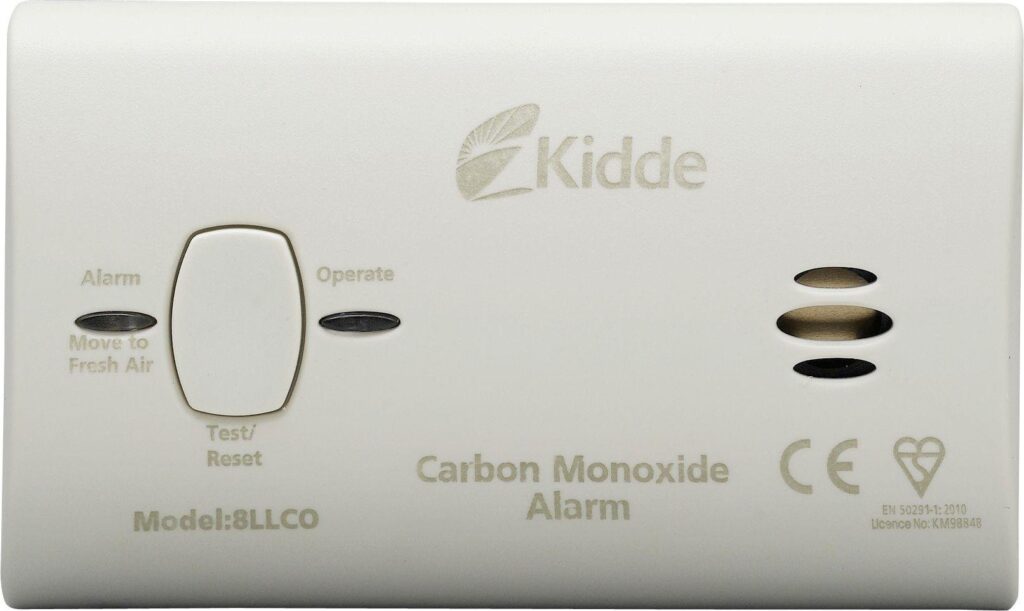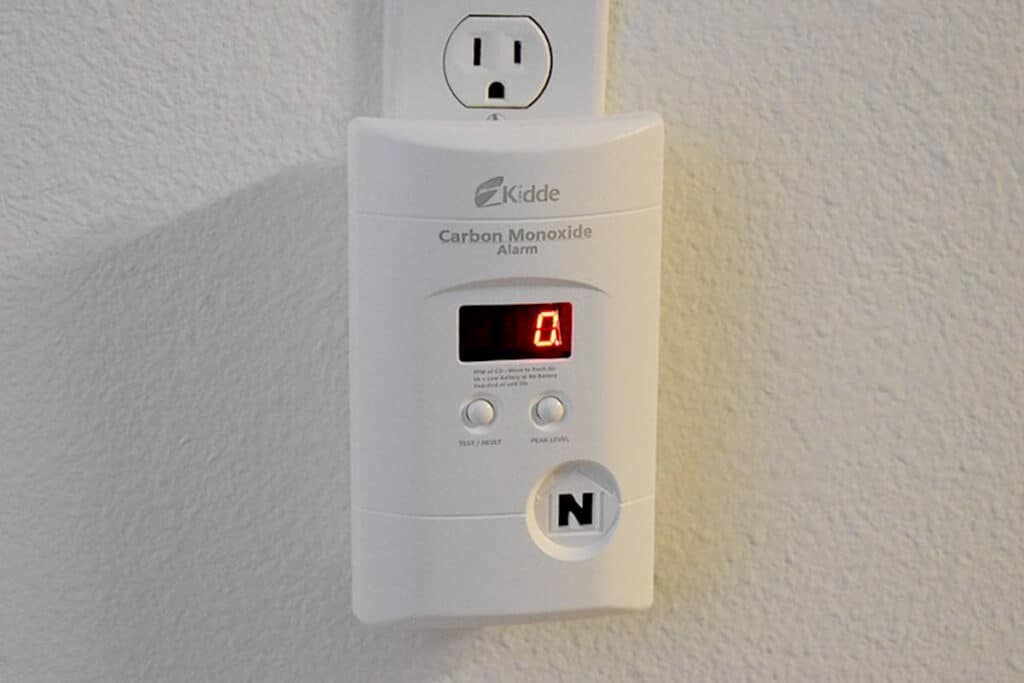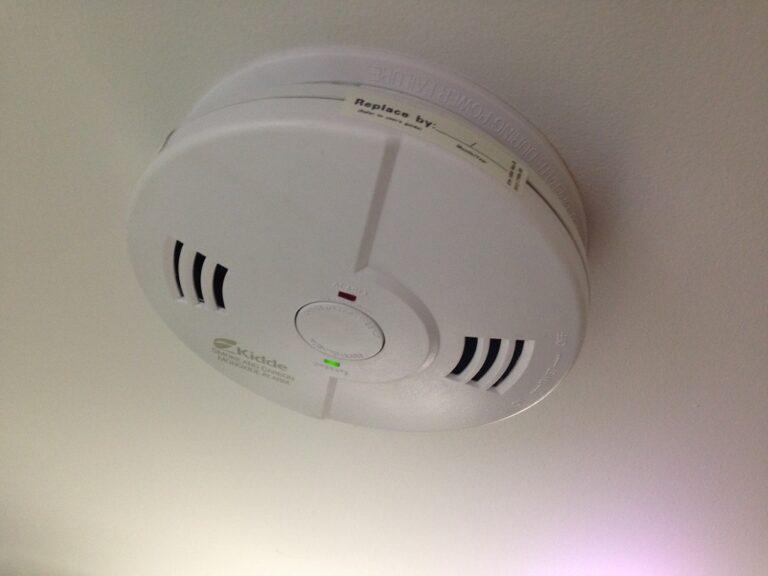Introduction
How Do Carbon Monoxide Detectors Work: Carbon monoxide detectors are essential devices that help protect us from the dangers of carbon monoxide (CO) poisoning. Carbon monoxide is a colorless, odorless, and tasteless gas that is produced by the incomplete combustion of fossil fuels such as gas, oil, and coal. It is highly toxic and can be deadly if inhaled in high concentrations. Therefore, having a carbon monoxide detector in your home or workplace is crucial for ensuring the safety of you and your loved ones.
These devices are designed to detect the presence of carbon monoxide in the air and alert you when levels become dangerous. They operate based on a chemical reaction that occurs when carbon monoxide comes into contact with certain materials inside the detector.
Most carbon monoxide detectors use one of two types of sensors: electrochemical sensors or biomimetic sensors. Electrochemical sensors contain electrodes immersed in a chemical solution. When carbon monoxide enters the detector, it reacts with the chemicals in the solution, causing a change in the electrical current flowing through the electrodes. This change in current triggers an alarm, indicating the presence of carbon monoxide.
Biomimetic sensors, on the other hand, are designed to mimic the way certain enzymes in the human body react to carbon monoxide. These sensors contain a gel-like substance that changes color when it comes into contact with carbon monoxide. The color change is detected by a light sensor, which then triggers the alarm.

What can trigger carbon monoxide alarm?
Carbon monoxide (CO) is a colorless, odorless, and tasteless gas that is produced by the incomplete combustion of fossil fuels such as coal, oil, and natural gas. It is highly toxic and can be deadly if inhaled in high concentrations. Carbon monoxide alarms are designed to detect the presence of this gas and alert individuals to its presence. There are several factors that can trigger a carbon monoxide alarm.
One of the most common triggers of a carbon monoxide alarm is a malfunctioning or poorly maintained fuel-burning appliance. This can include furnaces, water heaters, stoves, and fireplaces. If these appliances are not properly vented or if there is a problem with the combustion process, carbon monoxide can build up in the home and trigger the alarm.
Another potential trigger of a carbon monoxide alarm is a blocked or obstructed chimney or flue. If the chimney or flue is not clear, it can prevent the proper ventilation of carbon monoxide and cause it to accumulate in the home. This can occur if there is a buildup of debris, such as leaves or animal nests, or if there is a structural problem with the chimney or flue.
Additionally, a carbon monoxide alarm can be triggered by a leak in a fuel-burning appliance or its associated pipes or vents. If there is a crack or hole in the appliance or its components, carbon monoxide can escape into the home and set off the alarm. It is important to regularly inspect and maintain these appliances to ensure they are in good working order and do not pose a risk of carbon monoxide leaks.
There are several factors that can trigger a carbon monoxide alarm, including malfunctioning or poorly maintained fuel-burning appliances, blocked or obstructed chimneys or flues, and leaks in appliances or their associated pipes or vents. It is important to be aware of these potential triggers and take steps to prevent carbon monoxide buildup in the home to ensure the safety and well-being of occupants.
What is the liquid in a carbon monoxide detector?
A carbon monoxide detector is a device that is used to detect the presence of carbon monoxide gas in the air. Carbon monoxide is a colorless, odorless, and tasteless gas that is produced by the incomplete combustion of fossil fuels such as coal, oil, and natural gas. It is highly toxic and can be deadly if inhaled in high concentrations.
The liquid in a carbon monoxide detector is typically a chemical compound called potassium hydroxide (KOH). This liquid is used to absorb and react with carbon monoxide gas, producing a color change that indicates the presence of the gas. When carbon monoxide enters the detector, it reacts with the potassium hydroxide to form potassium carbonate (K2CO3) and water (H2O).
The reaction between carbon monoxide and potassium hydroxide is a redox reaction, meaning that it involves the transfer of electrons between the reactants. In this reaction, carbon monoxide is oxidized, losing electrons, while potassium hydroxide is reduced, gaining electrons. The overall reaction can be represented by the following equation:
2 KOH + 2 CO → K2CO3 + H2O
The color change that occurs when carbon monoxide is detected is typically due to the formation of potassium carbonate, which can have a different color than the original potassium hydroxide solution. This color change is usually accompanied by an audible alarm to alert individuals to the presence of carbon monoxide gas.
How effective are carbon monoxide detectors?
Carbon monoxide detectors are devices that are designed to detect the presence of carbon monoxide gas in the air. This gas is odorless, colorless, and tasteless, making it extremely difficult to detect without the use of a detector. Carbon monoxide is produced by the incomplete combustion of fossil fuels, such as gas, oil, and coal, and can be extremely dangerous if not detected early.
Carbon monoxide detectors are highly effective in detecting the presence of this gas and alerting individuals to its presence. They work by continuously monitoring the air for carbon monoxide levels and sounding an alarm if the levels become too high. This allows individuals to quickly evacuate the area and seek fresh air before the gas reaches dangerous levels.
One of the main reasons why carbon monoxide detectors are so effective is because they are highly sensitive to even small amounts of the gas. They are able to detect carbon monoxide levels as low as 10 parts per million (ppm), which is well below the level at which symptoms of carbon monoxide poisoning typically occur. This early detection can be life-saving, as it allows individuals to take action before they become seriously ill.
In addition to their sensitivity, carbon monoxide detectors are also highly reliable. They are designed to provide accurate readings and are not easily affected by other gases or substances in the air. This means that individuals can trust the readings provided by their carbon monoxide detector and take appropriate action if necessary.
Overall, carbon monoxide detectors are highly effective in detecting the presence of carbon monoxide gas and alerting individuals to its presence. Their sensitivity and reliability make them an essential safety device for any home or building that uses fossil fuels for heating or cooking.
How does a carbon monoxide alarm sound when it detects carbon monoxide?
A carbon monoxide alarm is designed to detect the presence of carbon monoxide gas in the air. When it detects carbon monoxide, it emits a loud and distinctive sound to alert the occupants of a potential danger. The sound produced by a carbon monoxide alarm is specifically designed to be easily recognizable and distinguishable from other sounds in the environment.
The sound emitted by a carbon monoxide alarm is typically a series of loud beeps or chirps. The frequency and pattern of the beeps may vary depending on the specific model and brand of the alarm. However, most carbon monoxide alarms produce a high-pitched sound that is intended to grab the attention of anyone in the vicinity.
The purpose of the loud sound is to ensure that people are alerted to the presence of carbon monoxide and can take immediate action to protect themselves. Carbon monoxide is a colorless and odorless gas that can be extremely dangerous if inhaled in high concentrations. It can cause symptoms such as headaches, dizziness, nausea, and even death. Therefore, it is crucial to have a carbon monoxide alarm that can effectively alert individuals to the presence of this gas.
When a carbon monoxide alarm detects carbon monoxide, it is important to take the alarm seriously and follow the appropriate safety procedures. This may include evacuating the premises, opening windows and doors to ventilate the area, and contacting emergency services for assistance. It is also important to regularly test and maintain carbon monoxide alarms to ensure their proper functioning.
Can a smartphone detect carbon monoxide?
Yes, a smartphone can detect carbon monoxide. Carbon monoxide (CO) is a colorless, odorless, and tasteless gas that is highly toxic to humans and animals. It is produced by the incomplete combustion of fossil fuels, such as gasoline, natural gas, and coal. Exposure to high levels of carbon monoxide can lead to carbon monoxide poisoning, which can be fatal.
Smartphones are equipped with various sensors and technologies that allow them to detect and measure different environmental factors. One such sensor is the gas sensor, which can be used to detect the presence of carbon monoxide in the air. These gas sensors work by measuring the concentration of carbon monoxide molecules in the surrounding environment.
There are several smartphone apps available that utilize the built-in gas sensor to detect carbon monoxide. These apps typically require the user to place the smartphone near a potential source of carbon monoxide, such as a gas stove or a car exhaust, and then analyze the readings provided by the sensor. The app will then alert the user if the carbon monoxide levels are above the safe threshold.
It is important to note that while smartphones can detect carbon monoxide, they should not be relied upon as the sole means of detection. Carbon monoxide detectors specifically designed for this purpose are more accurate and reliable. However, smartphone apps can serve as a useful additional tool for detecting carbon monoxide in certain situations, especially when a dedicated detector is not available.
Smartphones can indeed detect carbon monoxide using their built-in gas sensors. However, it is recommended to use dedicated carbon monoxide detectors for accurate and reliable detection. Smartphone apps can be a helpful supplementary tool in certain situations, but they should not be solely relied upon for carbon monoxide detection.
The purpose of carbon monoxide detectors is to protect individuals from the harmful effects of carbon monoxide (CO) gas. Carbon monoxide is a colorless, odorless, and tasteless gas that is produced by the incomplete combustion of fossil fuels such as gas, oil, and coal. When inhaled, carbon monoxide can bind to hemoglobin in the blood, reducing its ability to carry oxygen to vital organs. This can lead to symptoms such as headaches, dizziness, nausea, and even death.
Carbon monoxide detectors are designed to detect the presence of carbon monoxide in the air and alert occupants of a building to its presence. They do this by continuously monitoring the levels of carbon monoxide in the surrounding environment. When the concentration of carbon monoxide reaches a certain threshold, the detector will emit a loud alarm to warn individuals of the potential danger. This allows people to evacuate the area and seek fresh air before the levels of carbon monoxide become life-threatening.
How do carbon monoxide detectors detect the presence of carbon monoxide?
Carbon monoxide detectors are designed to detect the presence of carbon monoxide gas in the air. They do this by utilizing different types of sensors, such as electrochemical sensors, metal oxide semiconductors, or biomimetic sensors. These sensors are specifically designed to react to the presence of carbon monoxide and trigger an alarm when certain levels of the gas are detected.
Electrochemical sensors, for example, contain electrodes that are immersed in a chemical solution. When carbon monoxide comes into contact with the electrodes, a chemical reaction occurs, generating an electric current that is proportional to the concentration of carbon monoxide in the air. This current is then measured by the detector, and if it exceeds a certain threshold, the alarm is triggered.
Metal oxide semiconductor sensors, on the other hand, consist of a thin film of metal oxide that reacts with carbon monoxide. This reaction causes a change in the electrical resistance of the film, which is detected by the detector and used to activate the alarm. Biomimetic sensors mimic the way certain enzymes in the human body react to carbon monoxide, and they trigger an alarm when they come into contact with the gas.
What are the different types of carbon monoxide detectors available in the market?
When it comes to carbon monoxide detectors, there are several different types available in the market. Each type has its own unique features and advantages, allowing consumers to choose the one that best suits their needs and preferences.
One of the most common types of carbon monoxide detectors is the plug-in or battery-operated model. These detectors are easy to install and can be placed in any room of the house. They typically have a digital display that shows the current carbon monoxide levels, as well as an alarm that sounds when dangerous levels are detected. Some models also have additional features, such as a built-in thermometer or the ability to connect to a smartphone app for remote monitoring.
Another type of carbon monoxide detector is the hardwired model. These detectors are directly connected to the electrical system of the house and usually have a battery backup in case of a power outage. Hardwired detectors are typically more expensive than plug-in models, but they offer the advantage of being constantly powered and not relying on batteries. They are often installed by professionals and are commonly found in newer homes or buildings.
Can carbon monoxide detectors be used in all areas of a home or building?
Carbon monoxide detectors can be used in most areas of a home or building, but there are certain considerations to keep in mind. It is important to place carbon monoxide detectors in areas where carbon monoxide is most likely to accumulate. This includes areas near fuel-burning appliances such as furnaces, water heaters, and stoves. It is also recommended to have a detector on each level of the home, including the basement and any bedrooms.
However, there are some areas where carbon monoxide detectors should not be installed. These include areas with high humidity, such as bathrooms, as the moisture can affect the sensor’s performance. Additionally, detectors should not be placed near windows, doors, or vents, as these areas can introduce outside air and dilute the concentration of carbon monoxide.
Overall, it is important to carefully consider the placement of carbon monoxide detectors to ensure they are effective in detecting the presence of carbon monoxide. Following the manufacturer’s guidelines and local building codes can help ensure proper placement and maximize the safety of your home or building.
Are there any maintenance or testing requirements for carbon monoxide detectors?
Yes, there are maintenance and testing requirements for carbon monoxide detectors to ensure their proper functioning and reliability. Regular maintenance and testing are crucial to ensure that the detector is able to accurately detect the presence of carbon monoxide and provide timely warnings.
One important maintenance requirement is to regularly clean the detector to remove any dust or debris that may accumulate on the sensors. This can be done by gently wiping the detector with a soft cloth or using a vacuum cleaner with a brush attachment. It is also important to check the batteries of the detector regularly and replace them as needed. Most carbon monoxide detectors have a low battery indicator that will alert you when the batteries need to be replaced.
In addition to regular maintenance, it is recommended to test the carbon monoxide detector at least once a month to ensure its proper functioning. This can be done by pressing the test button on the detector, which will simulate the presence of carbon monoxide and trigger the alarm. It is important to follow the manufacturer’s instructions for testing the detector, as different models may have slightly different procedures.

Conclusion
Carbon monoxide detectors are essential devices that help protect us from the dangers of carbon monoxide poisoning. In this article, we have explored how these detectors work and the importance of having them in our homes. By understanding the principles behind their operation, we can better appreciate their role in keeping us safe.
Carbon monoxide detectors operate based on the principle of electrochemical sensing. They contain a sensor that reacts with carbon monoxide gas and produces an electrical signal. This signal is then processed by the detector’s circuitry, which triggers an alarm if the carbon monoxide levels exceed a certain threshold. This mechanism allows the detector to quickly and accurately detect the presence of carbon monoxide in the air.
One of the key advantages of carbon monoxide detectors is their ability to provide early warning signs of carbon monoxide buildup. Unlike our senses, which cannot detect this odorless and colorless gas, detectors can continuously monitor the air and alert us to potential dangers. This early warning can be crucial in preventing carbon monoxide poisoning and giving us enough time to evacuate the premises and seek medical help if necessary.
Carbon monoxide detectors are vital devices that play a crucial role in ensuring our safety. By employing electrochemical sensing technology, these detectors can detect the presence of carbon monoxide gas and provide early warnings to prevent potential harm. It is essential for every household to have carbon monoxide detectors installed in appropriate locations, such as near bedrooms and common areas. Regular maintenance and testing of these detectors are also necessary to ensure their proper functioning. By taking these precautions, we can significantly reduce the risks associated with carbon monoxide poisoning and protect ourselves and our loved ones.

